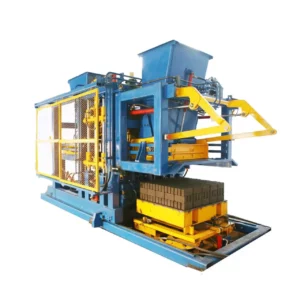Block making machines are versatile tools that can produce a wide variety of blocks and bricks, depending on the specific design of the machine and the type of molds or dies used.
Common types of blocks and bricks that can be produced using a block making machine include:
- Solid Blocks: These blocks are dense and solid throughout, often used for load-bearing walls and other structural applications.
- Hollow Blocks: Hollow blocks have one or more voids or cavities, which reduce their weight and material usage. They are used in both load-bearing and non-load-bearing applications.
- Interlocking Blocks: These blocks have unique designs that allow them to interlock or fit together without the need for mortar or adhesives. Interlocking blocks are often used for retaining walls, pavements, and erosion control.
- Paving Blocks: Also known as pavers or paving stones, these are used to create decorative and functional paved surfaces, such as walkways, driveways, and patios. Paving blocks come in various shapes, sizes, and patterns.
- Cinder Blocks: Cinder blocks, also known as concrete masonry units (CMUs), are rectangular or square blocks with hollow cavities. They are used in various construction applications, including walls, partitions, and foundations.
- Fly Ash Bricks: These bricks are made from a mixture of fly ash, cement, and other materials. They are known for their strength and thermal insulation properties.
- Perforated Blocks: These blocks have small holes or perforations, often used for ventilation and decorative purposes. They can also reduce the weight of the block.
- Specialty Blocks: Some block making machines are designed to produce specialty blocks with unique shapes or features, such as wave blocks, slope blocks, or corner blocks.
- Split Face Blocks: These blocks have a rough, textured surface and are often used for decorative or architectural purposes, providing an aesthetically pleasing appearance.
- Conventional Bricks: Some block making machines can produce traditional clay or concrete bricks, which are used in a wide range of construction applications.
The specific type of block or brick that a machine can produce depends on the machine’s design, the mold configuration, and the intended application. Engineers, architects, and builders select the type of block or brick based on the specific requirements of the construction project, taking into account factors like load-bearing capacity, insulation, aesthetics, and design flexibility. Block making machines offer versatility to cater to a wide range of construction needs.
Can you describe the main components and working principles of a typical block making machine?
A typical block making machine consists of several main components and operates based on well-defined working principles. These components work together to mix raw materials, shape them into blocks or bricks, and facilitate their curing or solidification.
Below are the main components and working principles of a typical block making machine:
Main Components:
- Hopper: The hopper is where raw materials, such as cement, sand, aggregate, and water, are loaded. These materials are stored in separate compartments within the hopper to control their proportions.
- Conveyor Belt: A conveyor belt or conveyor system transports the mixed raw materials from the hopper to the molding area. It ensures a consistent flow of material for the block-making process.
- Molds or Dies: Molds or dies are the components that shape the raw materials into the desired block or brick configurations. They can be customized to produce various block types and sizes.
- Vibrators: Vibrators are used to compact the raw materials within the molds. This compaction ensures that the final blocks are solid, well-formed, and free of voids.
- Hydraulic System: Many block making machines use a hydraulic system to exert force on the molds and ensure proper compaction. This system controls the movement and pressure of the molding process.
- Control Panel: A control panel allows operators to set parameters such as cycle time, pressure, and other settings. It also controls the various components of the machine, ensuring coordinated operation.
- Ejection System: Once the blocks are formed and compacted, an ejection system helps release them from the molds. This can involve hydraulic mechanisms or pneumatic systems.
- Curing Chamber or Area: After ejection, the newly formed blocks need to cure or solidify. Some machines have built-in curing chambers, while others may require manual transfer to a curing area.
Working Principles:
The working principles of a typical block making machine can be summarized as follows:
- Material Mixing: Raw materials, such as cement, sand, aggregate, and water, are accurately proportioned and mixed in the hopper. The mixing ensures a consistent composition and uniform distribution of materials.
- Material Feeding: The mixed material is then fed onto the conveyor belt, which carries it to the molding area.
- Molding and Compaction: The material is deposited into the molds. Vibrators are activated to compact the material, eliminating air voids and ensuring a dense block or brick. block machine for sale The molds are typically situated on a moveable platform that can be lowered and raised.
- Hydraulic Compression: In many block making machines, hydraulic systems apply pressure to the molds to compact the material. The hydraulic pressure is adjusted according to the desired block characteristics.
- Block Ejection: After compaction, the blocks are ejected from the molds. This can be a manual or automated process, depending on the machine’s design.
- Curing: The newly formed blocks need time to cure and gain strength. This can occur in a dedicated curing chamber or an outdoor curing area, depending on the machine’s design.
- Quality Control: Throughout the process, quality control measures are taken to ensure that the blocks meet the required standards for dimensions, strength, and appearance.
The specific design and operation of block making machines can vary, with some machines featuring automation, advanced controls, and specialized features for producing different block types. The key principles, however, remain consistent: proportioning, mixing, molding, compaction, curing, and quality control.
